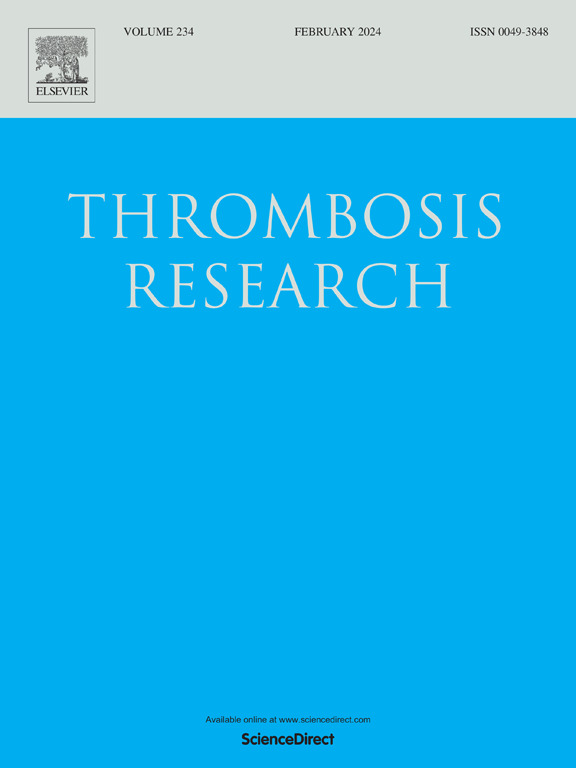线粒体 DNA 拷贝数及其与癌症患者静脉血栓栓塞症的关系
IF 3.7
3区 医学
Q1 HEMATOLOGY
引用次数: 0
摘要
静脉血栓栓塞(VTE)是癌症患者常见且严重的并发症。已知线粒体DNA (mtDNA)拷贝数影响参与癌症发展的各种细胞途径。虽然此前有报道称mtDNA降低与非癌症患者静脉血栓栓塞风险之间存在关联,但其与癌症患者静脉血栓栓塞的关系尚不清楚。因此,我们旨在通过一项来自维也纳癌症和血栓形成研究(CATS)的48例患者的巢式病例对照研究,研究mtDNA拷贝数与静脉血栓形成风险之间的关系,这是一项前瞻性观察性队列研究。使用基于qpcr的方法,在平均分布的年龄、性别、癌症类型和分期匹配的有和没有静脉血栓栓塞的患者中测量mtDNA拷贝数。48例患者中,24例诊断为静脉血栓栓塞(中位年龄[IQR] 62[57-60]岁,54.2%为女性),24例无静脉血栓栓塞事件(中位年龄[IQR] 63[58-71]岁,54.2%为女性)。我们发现,与未发生VTE的患者相比,发生VTE的患者mtDNA拷贝数较低(216.73[167.99-401.39]对301.47[210.66-526.84])。调整了年龄、d -二聚体、性别、癌症分期和BMI的多变量分析显示,mtDNA拷贝数每增加10个单位,VTE发生的几率就会降低5.9% (p = 0.021)。研究纳入时,远处转移癌(M1)患者的mtDNA拷贝数低于无远处转移的患者(220.34 [172.67-323.70]vs 328.48 [213.89-556.68];p = 0.052)。总的来说,我们的研究结果表明,癌症患者mtDNA拷贝数减少与静脉血栓栓塞风险增加之间存在潜在联系。本文章由计算机程序翻译,如有差异,请以英文原文为准。
Mitochondrial DNA copy number and its association with venous thromboembolism in patients with cancer
Venous thromboembolism (VTE) is a common and serious complication among cancer patients. Mitochondrial DNA (mtDNA) copy number is known to influence various cellular pathways involved in cancer development. While an association between reduced mtDNA and VTE risk in non-cancer patients was previously reported, its relationship with VTE in cancer patients remains unclear.
Therefore, we aimed to investigate the association between mtDNA copy number and VTE risk in a nested-case control study of 48 patients from the Vienna Cancer and Thrombosis Study (CATS), a prospective observational cohort study. The mtDNA copy number was measured in equally distributed age, sex, cancer type, and stage matched patients with and without VTE using a qPCR-based method.
Of the 48 patients, 24 were diagnosed with VTE (median age [IQR] 62 [57–60] years, 54.2 % female) and 24 had no VTE event (median age [IQR] 63 [58–71] years, 54.2 % female). We found that patients who developed VTE had lower mtDNA copy numbers compared to those without VTE (216.73 [167.99–401.39] vs 301.47 [210.66–526.84]). Multivariable analysis adjusting for chronological age, D-dimer, sex, cancer stage and BMI revealed that each 10-unit increase in mtDNA copy number decreased the odds of VTE occurrence by 5.9 % (p = 0.021). Patients with distant metastatic cancer (M1) had lower mtDNA copy numbers than those without distant metastasis at study inclusion (220.34 [172.67–323.70] vs 328.48 [213.89–556.68; p = 0.052).
Overall, our findings suggest a potential link between reduced mtDNA copy number and increased VTE risk in cancer patients.
求助全文
通过发布文献求助,成功后即可免费获取论文全文。
去求助
来源期刊

Thrombosis research
医学-外周血管病
CiteScore
14.60
自引率
4.00%
发文量
364
审稿时长
31 days
期刊介绍:
Thrombosis Research is an international journal dedicated to the swift dissemination of new information on thrombosis, hemostasis, and vascular biology, aimed at advancing both science and clinical care. The journal publishes peer-reviewed original research, reviews, editorials, opinions, and critiques, covering both basic and clinical studies. Priority is given to research that promises novel approaches in the diagnosis, therapy, prognosis, and prevention of thrombotic and hemorrhagic diseases.
 求助内容:
求助内容: 应助结果提醒方式:
应助结果提醒方式:


